We woke to find the neighbouring roofs covered in frost! Will the warmer weather never arrive? At least the sun was shining as we left Caen and headed along the free motorway towards Rennes and Brittany. Our route took us past Avranches and Mont St. Michel rising steeply out of the bay with the tall towers of the abbey on its summit. We continued beyond St. Brieuc taking the route towards Brest before entering Finistère and turning north to follow the coast road along through St. Pol de Léon and Roscoff.
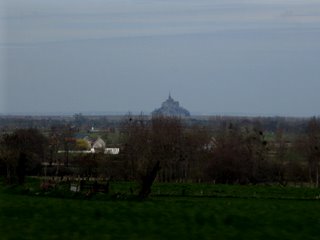 Mont St. Michel through the Modestine's window
Mont St. Michel through the Modestine's windowOur friends Danielle and Joël live in the little granite town of Guissény, right by the sea on the northern coast of Finistère. At night the beam from the lighthouse on the Ile de la Vierge can be seen from their kitchen window. Joël is a true Breton and loves the sea. Retired now, his pleasures are his little fishing boat and his large vegetable garden. He also plays the Breton bagpipes and on special occasions wears his black Breton hat. Danielle comes from the mountains of the Jura and has been a close friend of Jill's since we worked together in the school at Champagne-sur-Loue so long ago. Along with Susanne and Françoise whom we were with last autumn, Danielle takes much of the credit for teaching Jill to speak French as she never studied it at school.
We left Normandy, with its large, old, cream-coloured stone buildings, in bright if chilly sunshine. As we reached Finistère, with its pretty granite houses, steep black slate roofs surrounded by neat green lawns and hedges, the skies turned grey and our faithful companion, the rain, came scudding across the sky to rejoin us.
It is several years since we were last in Guissény and we are astonished at the amount of recent building taking place. As there has never been any real employment here we assume it is developing as a commuter village for Brest. We found the house deserted when we arrived so parked Modestine in the drive and walked up into the village centre for a much needed coffee in one of the two shabby bars while waiting for our friends to return.
Guissény is typical of many little towns and villages in Finistère where the small granite cottages cluster around the church with its crowded graveyard. The ornate granite church spires (clochers) can be seen for long distances across the flat landscape and are very picturesque. Beside the church here in Guissény stands an ossuary and an ancient granite Calvary adorns the churchyard.
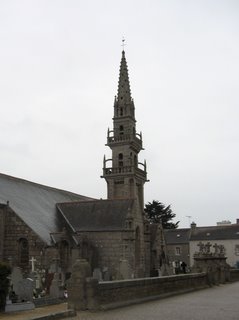 The church at Guissény
The church at Guissény 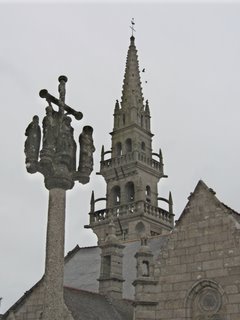 Bell tower and calvary, Guissény
Bell tower and calvary, Guissény 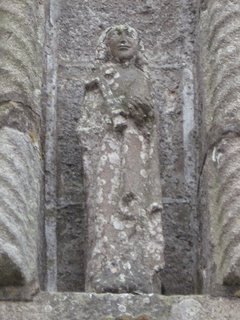 St Seny above the entrance to the church in Guissény
St Seny above the entrance to the church in GuissényHe holds the hammer he threw to select the place for his church
As we walked amongst the graves in the biting wind and spluttering rain we met an elderly lady searching for her tombstone. (It is the custom here to have a family grave and to know where you will be after your death.) She told us she now lived in Brest but came whenever she could to see the grave where her husband lay. As she moved amongst the close-packed granite tombs she stumbled and fell. With difficulty we got her back on her feet but she was very shaken. In tears she showed us the photo of her husband on the gravestone explaining he had been killed at the age of 31 in 1942 leaving her, aged 25, with a two year old daughter. In recent years the daughter had moved away and she now found herself at 89 years of age completely alone. She talked with love about her husband which brought her to tears. Her loss was as painful today as it had been 63 years ago! She obviously needed to talk and received comfort from us listening. Soon she was much calmer and fortunately didn't seem to have suffered from her fall. We offered to walk back to her home with her but she said she'd be fine. We watched nervously as she made her way out of the cemetery leaning heavily on her stick.
We made our way down to the sea shore where the tide was low, leaving a long, azure streak of sea in the inlet between two stretches of fine, clean white sand. On the far side stands Kerlouen, another little village of quaint granite cottages and a pretty church belfry. Here we found the cross of St. Seny amongst the dunes overlooking the water (Gui means village or town in Breton so Guissény is St. Seny's town.) Here too are the Barrachou, an outcrop of massive boulders amongst the sand that are magnificently picturesque with the pale blue sea behind. Not far away is the school Joël attended as a child and where his sons sat in the same classrooms a generation later. It stands right beside the inlet and during bad weather its windows are lashed by the force of the sea. It would be nice to say it is picturesque but we have to admit that it is large, dark, ugly and weatherworn. In common with most French schools and colleges, it was built for functionality rather than with any aesthetic ideal.
 Missionary cross on the beach, Guissény
Missionary cross on the beach, Guissény Along the beach, Guissény
Along the beach, Guissény The Barrachou rocks, Guissény
The Barrachou rocks, GuissényWe returned to the house to find Joël had just returned and was peering into Modestine to see if we were sleeping inside. After a cheerful welcome we went indoors for some welcome warmth and were soon joined by Danielle. The rest of the evening was spent very happily catching up on several years of news over supper.
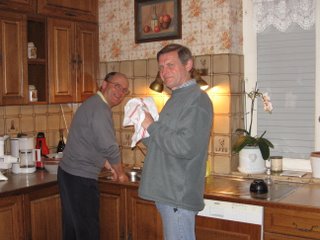 Men at work! Guissény
Men at work! GuissényWednesday 12th April 2006, Guissény, Brittany
When we recounted the incident in Guissény churchyard to Danielle and Joël last night they told us that they too had their own tomb waiting for them and had been delighted to find an old granite cross bearing a carved figure of Christ to surmount it. This morning as we were at breakfast the town gravedigger knocked at the door to say he was very sorry but he'd accidentally reversed his digging machine into their grave and managed to smash the cross into three pieces. As he happened to have a spare one knocking around with a metal Christ rather than a granite one, would they like him to fix it up for them? As we said yesterday, the graveyard is tight-packed with no room to move between the tombs so the damage was not surprising. We did think however, that if people didn't actually have their tombstones erected until they needed them, the churchyard might be a little less crowded. Our friends' view though is that it is better to have the pleasure of seeing it while you can. After a brief doorstep discussion the offer of the replacement cross was rejected and the gravedigger undertook to seek out something more similar for them. "Cherchez bien et prenez votre temps, je ne suis pas du tout pressée" (Take your time, I'm in no great hurry) Danielle told him amidst chuckles of laughter.
This afternoon Joël was keen to show us his beloved coastline so, after lunch, we all set off westward towards the Abers or drowned valleys, where small rivers wind through miniature fjords lined with yellow gorse towards the rock-strewn sea. We stopped at various points along the Aber Wrac'h to see the port where the fishermen were winding their nets and the oyster farms lay by the banks of the Aber.
 Winding nets at Aber Wrac'h
Winding nets at Aber Wrac'h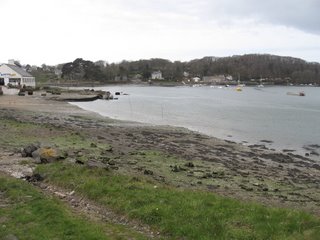 Oyster farm at Aber Wrac'h
Oyster farm at Aber Wrac'h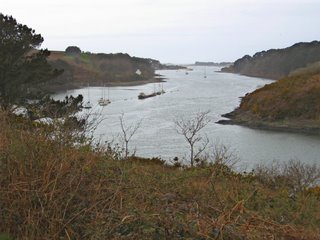 Aber Wrac'h
Aber Wrac'hThen we made our way back towards Guissény stopping to look across several tiny bays with bright little boats bobbing on their moorings and the red floats marking the location of crab pots. The bays were calm within the perilous limits of huge rocks, many submerged at high tide. Just offshore stood the granite tower of the lighthouse, the tallest in Europe, on the Ile de la Vierge, dwarfing the tower that it had replaced.
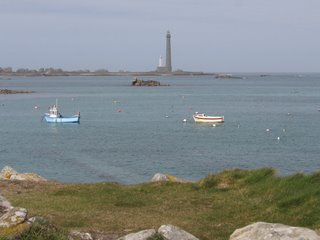 Lighthouse on the Ile de la Vierge
Lighthouse on the Ile de la ViergeFurther on the rocks along the shoreline and scattered across the sea became more rugged and we descended from a rocky headland to Curnic, an area of dunes and flat marshlands protected by a dyke. An egret stood on a small rock which broke the surface of a mere surrounded by reeds. It was near here that Joël moors his fishing boat, which he has spent much of the winter overhauling.
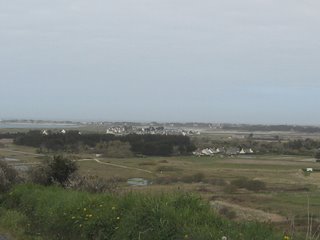 Le Curnic
Le Curnic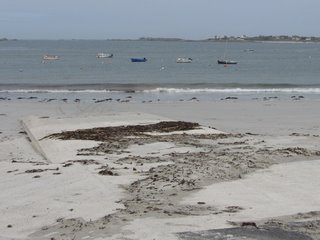 Boats in the bay at Le Curnic
Boats in the bay at Le CurnicWe passed back through the new housing along the sea front at Guissény. Regrettably some of it is quite out of keeping with the granite and white slate-roofed Breton houses, being either roofed with pantiles like Spanish houses or clad with wood like Scandinavian buildings. To the east of Guissény lies the straggling commune of Kerlouan and here we explored the unspoiled coastline with its fantastically shaped granite rock formations, some reminiscent of heads or in the form of fishes. The sea has retreated in this part of the coast leaving the massive outcrops of sculpted rock sprouted in the middle of gardens or lying stranded, surrounded by sandy fields.
 Poisson d'avril, rock formation near Meneham
Poisson d'avril, rock formation near Meneham Granite boulder shaped by the sea and now inland at Kerlouan
Granite boulder shaped by the sea and now inland at Kerlouan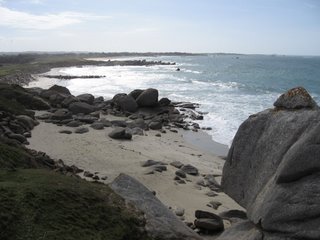 The coast at Kerlouan
The coast at Kerlouan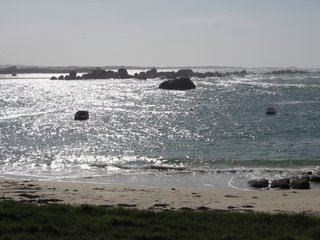 The coast at Kerlouan
The coast at Kerlouan The coast at Kerlouan
The coast at Kerlouan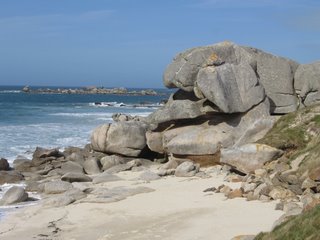 The coast at Kerlouan
The coast at KerlouanOur goal was Meneham. The last time we visited it had been a derelict fishing village, but now it is being restored as an interpretation centre with a restaurant and tourist accommodation. To the seaward side of the village on a sandy headland above the beach lies a long shallow granite-lined pit where in the past seaweed was burned to extract soda. There are heaps of seaweed stacked to dry nearby. Behind is a large rocky outcrop with a granite guardhouse nestling in a crevice. It had once been a customs house but was later occupied by fishermen. Sheltering behind the rock are several rows of fishermen's cottages, some already restored either with thatch or slate roofing, depending on what was recorded in old photographs. Others are still open to the sky and some still in an untouched and romantic ruinous state, rather like a Samuel Prout etching of tumbled Devon thatched cottages.
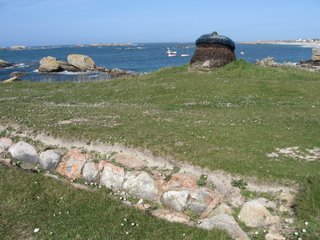 Pit for burning seaweed to extract soda at Meneham
Pit for burning seaweed to extract soda at Meneham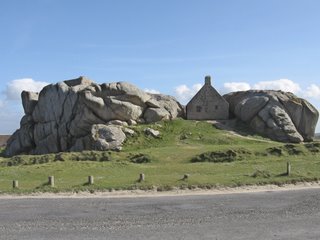 Guard house in the rocks, at Meneham
Guard house in the rocks, at Meneham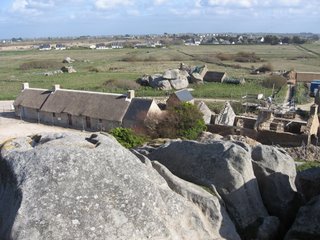 Meneham, the village from the rock
Meneham, the village from the rockWe spent some time wandering around the village before making our way home past a tiny chapel called la chapelle du Croazou in the middle of the road, surrounded by the roughly carved granite crosses of a type that is common at road junctions in this part of Brittany as well as in Cornwall, which shares its early Christian heritage including many of its saints – St Sezny for example is none other than Cornwall's St. Sithney.
 Chapelle du Croazou
Chapelle du CroazouWe returned home in time for an appointment with Danielle and Joël's granddaughter Glwadys, aged three, courtesy of the wonders of the webcam. Some 1000 kilometers away in eastern Lorraine she danced to her music box for the four faces huddled in front of the camera in Brittany while her mother struggled to prevent her baby brother from chewing the microphone cable and obscuring the camera with a paper bag. Danielle has become expert in this type of communication after only a short period of owning a computer and we are quite taken with the idea of installing something similar when we return from our travels.
Thursday 13th April 2006, Guissény, Brittany
This morning Joël went off to plant his shallots and rotivate the huge vegetable garden behind the house. Meanwhile we drove to Lesneven through the treeless open countryside, filled with bright gorse and primroses, and offering frequent views of the sea. Here we did some essential shopping prior to moving on tomorrow, at Leclerc, one of France's main supermarket chains. M.Leclerc actually started his first enterprise here in Brittany, being a native of Landerneau.
For lunch we were told to expect fish and chips! Yes, it was, but not as we know it! Joel cooked the chips. They were perfection and started life in his vegetable garden. One day last summer he went off in his little boat, also called Danielle, fishing for mackerel and returned home triumphant with 150 of them! They don't freeze well and there really is a limit to how many times they can be eaten in a few days! So Danielle went onto the internet to seek help. The result is a cupboard full of bottled mackerel cooked in a mustard and white wine sauce and they seem to keep for ever. They are extremely substantial though and we were all groaning before the jar was more than half used!
During the afternoon Danielle when off to her art club where she produces beautiful pieces of hand-painted porcelain, and Joël planted out his potatoes. Left to our own devices we decided to visit the Pointe St. Mathieu, the most westerly point of Finistère, eerily similar to Finisterre in Spain and Land's End in Cornwall. We followed the northern coastal route along beside the Aber Benoît stopping opposite the tiny offshore island of Melon with its old guard house, a lookout point to counter English attacks in the 17th century, and a pit for extracting soda from algae.
On this remote windswept headland we found an unexpected link with home through Queen Henrietta Maria, wife of Charles I, who had sought refuge in Exeter during the Civil War before fleeing to France. On 25 July 1644 the Dutch ship carrying Henrietta Maria was driven aground at Melon by the wind. The Queen, accompanied by her young daughter had to wait here before going on to reach Brest and then Paris.
All such historical speculations were cut short when we found a wallet filled with some 20 Belgian credit cards, road rescue cards and various club cards lying on a bench. We ended up wasting much of our afternoon trying to find somewhere safe to leave the cards while leaving a note on the seat in case the owner returned, explaining where to find them. Finally we took them to the nearest mairie at Porspoder and asked them to contact the owner's bank to say they had been found, were safe and awaiting collection and not to cancel them when the owner reported them missing. Losing every card like that while on holiday is a worst nightmare scenario!
Finally we reached Pointe St. Mathieu with its modern lighthouse and the remains of the stone tower of the original mediaeval beacon. Formerly a busy little town with a parish church and abbey, today it has little more than a tiny chapel and the ruins of the beautiful abbey, pillaged for stone from the time of the Revolution. Off shore lies an archipelago of small islands, the largest being Ouissant (Ushant) and Molène. On the cliff top stands an imposing monument to the sailors of France who died during the First World War.
 Lighthouse and abbey at Pointe St. Mathieu
Lighthouse and abbey at Pointe St. Mathieu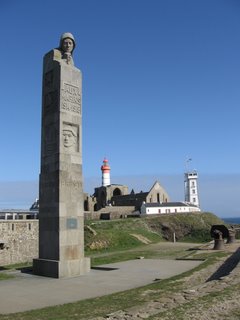 Memorial to French mariners, Pointe St. Mathieu
Memorial to French mariners, Pointe St. Mathieu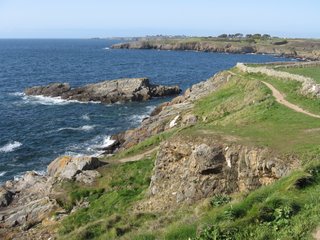 View from Pointe St. Mathieu
View from Pointe St. Mathieu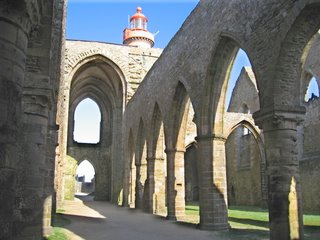 Abbey ruins at Pointe St. Mathieu
Abbey ruins at Pointe St. Mathieu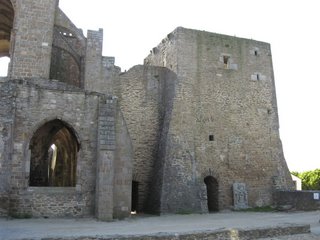 Tower of original mediaeval lighthouse at Pointe St. Mathieu
Tower of original mediaeval lighthouse at Pointe St. MathieuWe were frustrated that having come so far, we'd wasted well over an hour on the way and now needed to return long before we were ready to do so. We took the faster route back to Guissény but it was well after 7pm before we arrived to find supper already waiting.
Friday 14th April 2006, Crozon Peninsula, Brittany
Although it is Good Friday it is not a public holiday in France. Today we moved on from Guissény to explore something of the rest of Brittany. We have spent a delightful couple of days with our friends on the north Breton coast which holds a special place in our affections, not least because we have been so readily accepted into the life of the local community. During previous visits we have enjoyed activities ranging from Breton dancing in the village hall, helping select a student with an aptitude for English to work in the tourist information office, taking part in a kig-a-faz at the local school (regional dish of pork and cabbage enjoyed by most of the residents of Guissény as a fund raising activity) and taking part in the "Pardon" when the remains of St. Seny are paraded through the town to the sound of bagpipes and an unbelievable amount of fun, food and wine is enjoyed by everyone.
This time though, things have been a little different. Danielle has not been well for some time and although she has improved greatly over the last few months, she still has a long way to go. Our visit was therefore primarily to see her and Joël and assure ourselves that Danielle's health is gradually improving.
We spent this morning at the house with them, Danielle showing us some of the latest pieces of painting on Limoges porcelain she has produced. She is really a very gifted artist. Not to be outdone, Joël gave us a recital on the Breton bagpipes to prove that he has made considerable progress since we were last here. On a previous visit he had us all practicing the local dances we had learnt around the dining room table as he played the tunes. Today we contented ourselves with listening, having forgotten most of the steps we'd previously been taught.
 Typical Breton architecture – our friends' home, Guissény
Typical Breton architecture – our friends' home, Guissény Breton interior, Guissény
Breton interior, Guissény In the front garden, Guissény
In the front garden, Guissény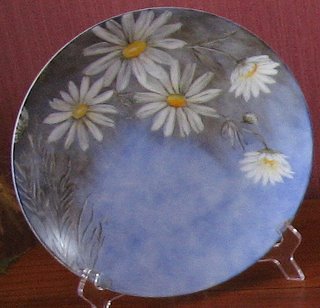 Example of Danielle's work
Example of Danielle's work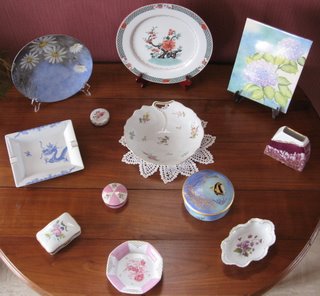 Examples of Danielle's work
Examples of Danielle's work Examples of Danielle's work
Examples of Danielle's work Example of Danielle's work
Example of Danielle's work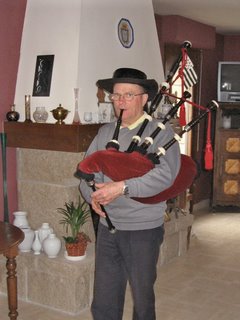 Soothing music from Joël, Guissény
Soothing music from Joël, GuissényLunchtime meant a lesson from Joël in making Breton pancakes. They were eaten accompanied by bowls of local cider, after which we bid our hosts goodbye and set off southwest towards the Crozon Peninsula at the far end of Finistère. For the first time in nearly five weeks we are back on our travels, alone with Modestine.
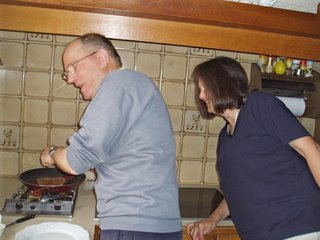 Making Breton pancakes, Guissény
Making Breton pancakes, Guissény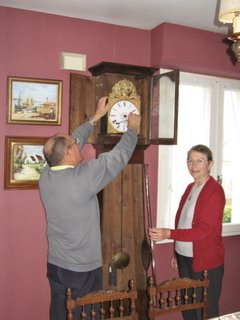 Time to move on again
Time to move on againThis tip of Brittany is very similar to the far west of Cornwall. Even the little towns have a definite Cornish feel and the cliff-tops could as easily be in the west of Britain as the west of Bretagne. Small grey granite cottages with slate roofs tumble down either side of the village streets to a small harbour where tiny fishing boats are moored. The hedgerows are filled with primroses and the white bell-shaped Cornish leeks while the cliff-tops are smothered in tufts of pink thrift. Each little village here has is small granite church with it decorative bell tower and carved statues of the saints. Frequently these churches are dedicated to the same Celtic saints as those found in Cornwall and there is a similarity in the place names here and those found in Penwith. Here, hundreds of villages have names starting with Lan, Pen, Pol and Plou and they all seem very similar. It's hardly surprising we keep getting lost. As Ian says, "Plou ça change, plou c'est la même chose!"
So this evening found us here in the little town of Crozon at the centre of the peninsula. We've seen camping cars around but where they go to at night is a mystery. We found one of the few all year campsites open here. It is run-down and deserted but will have to do. We have sat outside for supper the first time since leaving Portugal, where we enjoyed a bottle of local cider, Jill having had to abstain at lunch-time in order to be fit to drive. It was cold, light and sparkling. Quite delicious.
After supper we walked up into the town and found the church full as local people turned up for the Good Friday service of blessing the Croix de Crozon which was ceremoniously carried into the church.
